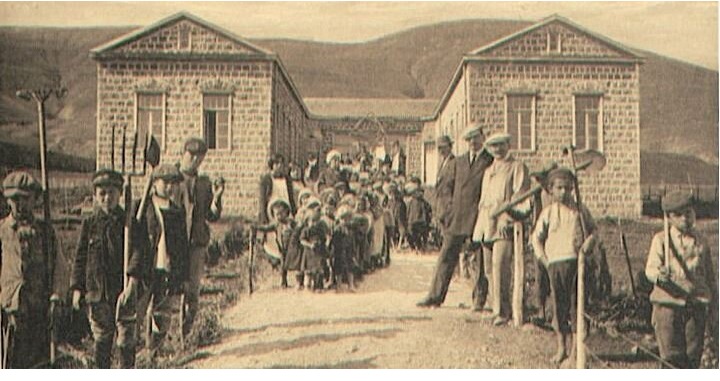A community of the Second Aliyah, captured in 1910-11 by Ya’acov Ben Dov, father of the Hebrew Film. From israelallianceinternational.com
THE SECOND 'ALIYA'
The second 'aliya' - 'ascent' of relatively large numbers to Palestine - started in 1904 in the wake of events in Kishinev and Gomel and continued through the 'revolution' of 1905 and the restoration of Russian government authority in 1906-7. The numbers were relatively large in relation to the normal pattern of emigration to Palestine, but they were pitifully small in relation to emigration to the United States. As mentioned in an earlier article in this series, Jonathan Frankel gives as figures for Jewish emigration to the United States:
1900: 37,011
1904: 77,544
1905: 92,388
1906: 125,234 (1)
(1) Joseph Frankel: Prophecy and Politics - Socialism, Nationalism and the Russian Jews, 1862-1917, Cambridge University Press, 1984 (first published 1981), p.135.
The connection to the events surrounding the 1905 revolution is obvious. Of the emigration to Palestine, Frankel says: 'While close to 1,000,000 Jews left the Russian Empire for the United States alone in the decade before the First World War, a mere 20,000-30,000 settled in Palestine, and that is far from the whole story. No more than a third, or perhaps a quarter, of this number can be classified as youth. The majority were older people driven by traditional religious motives to come to the Holy Land. In many cases indeed the aim was not so much to live in the country as to ensure that one died and was buried there.'
He continues:
'However, more remarkable than the low number of those coming was the huge percentage of youth who left during the decade of the Second Aliya. On one occasion Ben Gurion asserted that no more than ten percent had remained in the country. A survey made at Jaffa for the year 1912 produced the information that (the Yemenites apart) some 750 prospective immigrants entered the city through that port, while almost exactly the same number had left.'
He concludes: 'it follows, however extraordinary the fact may seem, that the more or less permanent force of labour youth - the group considered synonymous in popular parlance with the "Second Aliya" - was no more that a few hundred strong.'
Yet Frankel still insists that this group was decisively important: 'It is improbable that a Jewish state could have been created without their intrusion into the Yishuv.' The importance was psychological rather than numerical and had its origins in the experience of the events surrounding the 1905 revolution:
'The hard core within the immigrant youth, perhaps no more than two or three hundred, were charged to an exceptional degree with political energy - an energy drawing its force from the Russian revolutionary experience, on the one hand, and from Jewish messianism, on the other. The revolution had provided them, first, with a heightened belief in themselves, the youth, as the natural source of political leadership. Increasingly, in the period between the Kishinev pogrom and the assembly of the First Duma [April 1903-March 1906 - PB], the very young had come to dominate Jewish politics in the Pale of Settlement. Those who had grown up in those tumultuous times took for granted that not only their future but also the present belonged to the youth. Second, they brought with them from this contact with the revolution and with radical thought in Russia generally a sharp cutting critical spirit, a profound urge to negate the existent, to damn every compromise or hypocrisy, every tradition as an obstacle to freedom and every sign of comfort as bourgeois.' (all the above quotations from pp.366-7)
In wanting to discuss the Second Aliya and its consequences in Palestine I will be rather drifting away from the concerns of Solzhenitsyn. Solzhenitsyn is mainly interested in Zionism as a possible solution to Russia's Jewish problem. He broadly accepts the Zionist thesis that the Jews are a distinct people, a distinct nation, who could only find fulfilment as a people if they have their own national territory. Solzhenitsyn sees only two peoples - Russians and Jews. There is the complication that 'Russians' also include Ukrainians, Belorussians, Poles and, in the case of Kishinev, Roumanians. But they serve Solzhenitsyn mainly as a means of distancing the Russians proper from the worst excesses of antisemitism in the Pale. He has little enough to say about their own distinct existence, and the consequences of Zionism for the Arab population of Palestine are of no interest to him.
Nonetheless, the emergence of the state of Israel and the Jewish mentality that accompanied it - so very different from the traditional Judaism prior to the nineteenth century - was largely a consequence of the events in the Russian Empire that Solzhenitsyn describes in his book and that I have attempted to follow in this series of articles, a story that climaxes in the brutality of 1905 and the new Jewish self assertiveness that accompanied and provoked it. The great example of this is the pogrom in Odessa that followed Nicholas II's manifesto proclamation on October 17th (O.S.).
